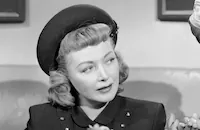Girl Without a Room
Cast & Crew
Ralph Murphy
Charles Farrell
Charles Ruggles
Marguerite Churchill
Gregory Ratoff
Grace Bradley
Film Details
Technical Specs

Synopsis
Tom Duncan, who hails from Sunville, Tennessee, wins an art scholarship in Paris with his naturalistic painting "The Thorn." He rents a flat in the Montparnasse district at the insistence of Kay Loring, a tenant of an apartment building who immediately recognizes his complete naiveté and timidity. She commandeers his funds to pay for her rent and a veritable feast for all the resident starving artists. Fellow artist Vergil Crock convinces Tom that his painting style is outdated and that he must adopt a more abstract manner. Crock also introduces gold digging seductress Nada, the daughter of a Russian family living in the same building, and leads Nada to believe that Tom is wealthy. Although Kay and Tom fall in love, she stands him up to join her former boyfriend, amiable alcoholic Arthur Copeland, for his birthday dinner. Tom is hurt, and that night, Nada takes him to a nightclub, where they watch a painted lady dance and Nada plies Tom with champagne. The drunken Tom is seduced by Nada, who convinces him that Kay is a tramp. While Kay is out with Copeland, he proposes to her, but she rejects his offer because she loves Tom, although she wishes to remain friends with Copeland. Tom's disillusionment and Nada's influence compel him to completely alter his lifestyle. He ignores Kay and drinks champagne continuously as inspiration for his abstract painting, "The Wheel of Life," while Nada fritters away his funds. Crock attempts to correct the situation by telling Kay that Tom is heartbroken, but when they walk into Tom's apartment, he is wrestling with Nada. Kay leaves, unaware that Nada has been mercilessly tickling a resistant Tom in order to get money out of his pocket. When Tom tells Crock about Nada's lies about Kay, Crock angrily drags her out of the room. His manhandling of the unmanageable Nada infuriates her father, who challenges him to a duel. Later, Crock brings Kay to a party where Tom's painting is unveiled. Tom receives admiration from all but Kay, who tells him that his new pals are phonies and chiselers, and that the painting is trash. Tom slaps her, and Kay returns to Copeland and accepts his proposal. On Bastille Day, Crock manages to survive the duel with Nada's father, although the Russians believe he is dead. He later tells Copeland that his engagement to Kay is a mismatch. Tom becomes the laughing stock of Paris when he wins an art contest, but then loses after informing the judges that they judged his painting while it was upside down. Nada's shock upon finding out that Tom is broke finally exposes her greed, and Tom and Kay renew their friendship. Copeland understands the wisdom of Crock's advice and, on his wedding day, pretends to be drunk and tells Tom and Kay to marry before he sobers up. The marriage starts off well after Tom gets a contract with a puzzle manufacturer that wants to market his paintings. As Crock and Copeland console each other, Copeland is forced to carry Crock out of the apartment building so the watchful Russians will continue to believe he is dead.

Director
Ralph Murphy
Cast

Charles Farrell

Charles Ruggles

Marguerite Churchill

Gregory Ratoff
Grace Bradley
Walter Woolf
Sam Ash
Leonid Snegoff

Leonid Kinsky

Mischa Auer
Alexander Mellish
Perry Ivins
William P. Colvin
Spec O'donnell
Frank Hammond
Maxine Cook
Edith Fellows
Edna May Bender
George Ernest
Baby Barnes
John T. Murray
Lorin Raker
Carl Fisher
Adrian Rosley
George Davis
Alice Ardell
Nina Borget
Nada Efron

Lew Kelly
George Leggewie
Harry Stubbs
William P. Carlton
Andre Cheron
Charles Millsfield
Ernest Young
Eric Mayne
Joyzelle
Chamberlin And Hines
John Binns
Lon Poff
Spunky
James T. Mack
Albert Roccardi
Ferdinand Munier
Jerry Frank
August Tollaire
Jean Malin
Crew

Film Details
Technical Specs

Quotes
Trivia
Notes
The working titles of the film were No Bed of Her Own and She Made Her Bed, which was later used for another Paramount film based on an entirely different source (see below). A news item in Film Daily noted that P. J. Wolfson and Allen Rivkin were assigned to write the adaptation of Lait's story, but they were not credited on the film. The MPAA/PCA files at the AMPAS Library include an April 1932 letter from Will H. Hays of the MPPDA to Adolph Zukor, Paramount executive, recommending that neither the working titles nor final title be registered as the original story was too suggestive. A September 1933 letter from the AMPP to Paramount noted that the film would be in violation of the Code "inasmuch as it seems to us to deal with a seduction treated in a comedy vein...." In November 1933, the AMPP recommended in a letter to Paramount that they "tone down comedy wrestling match...with particular reference to the latter part of it, where the girl loses her shirt, and also the various shots of her legs wrapped around Ruggles' neck." Scenes frequently deleted by state censors were Crock and Nada wrestling, the "muscle" dance and Joyzelle's dance in the nightclub. In 1935, the PCA labelled the film "Class I," indicating that the "release of the picture be halted now and that no additional contracts be taken on."
Pre-release Hollywood Reporter news items noted that Carole Lombard and Roland Young were slated for leading roles, and that Jean Malin was also cast. Additional news items in Hollywood Reporter noted that Ricardo Cortez and Wynne Gibson were slated for roles in this film. This was Broadway musical-comedy star Walter Woolf's film debut. The Call Bureau Cast Service lists Adrian Rosely's character as "Pierre," while the pressbook lists him as "Henri," and lists August Tollaire as "Pierre." Also according to the pressbook, Charles Farrell learned his Southern drawl from "Cracker" Henderson, Jack Oakie's valet. In addition, Joyzelle's costume in her exotic dance consists almost entirely of paint. The situation in which an artist's painting was judged while hanging upside-down was apparently based on a real-life occurrence: Edwin W. Dickinson's painting "The Fossil-Hunters" was given an award by the National Academy of Design in 1929 while hanging upside down. The painting also appeared this way for the 1928 Carnegie International Exposition. This fact was noted in the pressbook, although it did not claim this occurrence was the inspiration for the film. The opening and closing sequences of the film include a song-filled Paris street scene, similar to one in Rouben Mamoulian's 1932 film Love Me Tonight, starring Maurice Chevalier and Jeannette MacDonald (see below). Music copyright records note that a song from this film, "You and I," was copyrighted to Mary Frances Martin, however, this song was not heard in the film.












